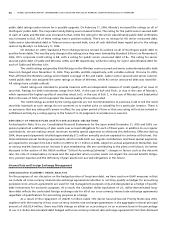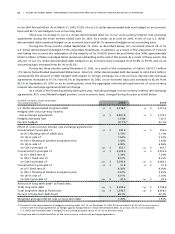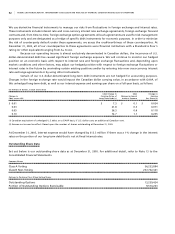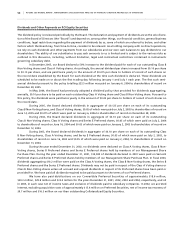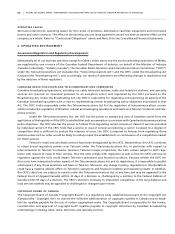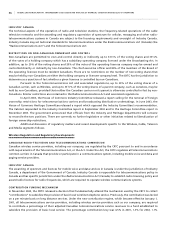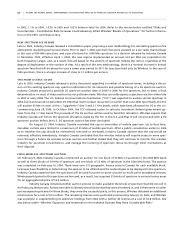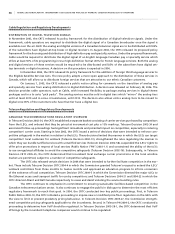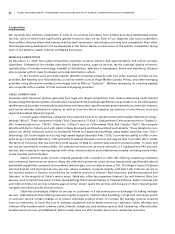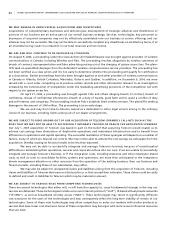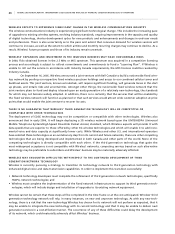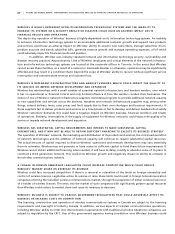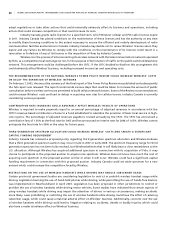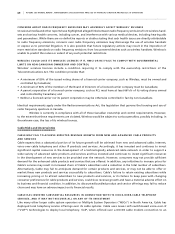Rogers 2005 Annual Report Download - page 64
Download and view the complete annual report
Please find page 64 of the 2005 Rogers annual report below. You can navigate through the pages in the report by either clicking on the pages listed below, or by using the keyword search tool below to find specific information within the annual report.
60 ROGERS 2005 ANNUAL REPORT . MANAGEMENT’S DISCUSSION AND ANALYSIS OF FINANCIAL CONDITION AND RESULTS OF OPERATIONS
Competition
We currently face effective competition in each of our primary businesses from entities providing substantially similar
services, some of which have significantly greater resources than we do. Each of our segments also faces competition
from entities utilizing alternative communications and transmission technologies and may face competition from other
technologies being developed or to be developed in the future. Below is a discussion of the specific competition facing
each of our Wireless, Cable, Telecom and Media businesses.
WI R E LE S S C OM P E TI T IO N
At December 31, 2005, the highly-competitive Canadian wireless industry had approximately 16.8 million wireless
subscribers. Competition for wireless subscribers is based on price, scope of services, service coverage, quality of service,
sophistication of wireless technology, breadth of distribution, selection of equipment, brand and marketing. Wireless
also competes with its rivals for dealers and retail distribution outlets.
In the wireless voice and data market, Wireless competes primarily with two other national wireless service
providers, Bell Mobility and Telus Mobility, as well as resellers such as Virgin Mobile Canada, Primus, and other emerging
providers using alternative wireless technologies such as WiFi or “hotspots”. Wireless messaging (or one-way paging)
also competes with a number of local and national paging providers.
CA B L E C OM P ET I T IO N
Canadian cable television systems generally face legal and illegal competition from several alternative multi-channel
broadcasting distribution systems, including two Canadian direct broadcast satellite service providers, U.S. direct broadcast
satellite service providers, terrestrially-based video service providers, satellite master antenna television, and multi-channel,
multi-point wireless distribution systems, as well as from the direct reception by antenna of over-the-air local and
regional broadcast television signals.
In recent years, telephone companies have acquired licences to operate terrestrial broadcast distribution under-
takings (“BDUs”). These companies include TELUS Corporation (“TELUS”), Saskatchewan Telecommunications (“Sasktel”),
MTS Communications Inc. (“MTS”), Aliant Inc. (“Aliant”) and, as of November 2004, Bell Canada (“Bell”). We compete
directly with Bell in Ontario and with Aliant in New Brunswick and Newfoundland and Labrador. These telephone com-
panies can deliver television service to residential homes and apartment buildings using digital subscriber line (“DSL”)
technology. DSL technologies such as very high-speed digital subscriber lines (“VDSL”) provide the ability to offer a com-
plete array of standard definition, VOD and SVOD broadcast television services and may be able to provide HDTV. Under
the terms of its licence, Bell has until the fourth quarter of 2006 to commercially launch its terrestrial BDU. To date, Bell
has not yet launched its terrestrial BDU. Our premium services, such as movie networks, U.S. superstations, PPV and VOD
services, also compete to varying degrees with other communications and entertainment media, including home video,
movie theatres and live theatre.
Cable’s Internet access services compete generally with a number of other ISPs offering competing residential
and commercial Internet access services. Many ISPs offer dial-up Internet access services that provide significantly reduced
bandwidth capabilities compared to broadband technologies, such as cable modem or DSL. The Rogers Yahoo! Hi-Speed
Internet Express and Internet Extreme services, where available, compete directly with Bell’s DSL Internet service in
the Internet market in Ontario, and with the DSL Internet services of Aliant in New Brunswick and Newfoundland and
Labrador. In the majority of Cable’s service areas, Cable also offers less expensive Internet Lite and Internet Ultra-Lite
services, each of which have lower modem speed settings than Internet Express or Internet Extreme. Cable’s Internet Lite
and Internet Ultra-Lite services compete against similar slower speed DSL services and, because of their reduced speed,
compete more directly with dial-up services.
Cable has increasingly offered its services to customers at a discounted price in exchange for taking multiple
services. Cable believes that offering customer loyalty programs, multi-product bundling, a single bill and single points
of customer service contact enables us to reduce individual product churn, to increase the average revenue received
from our customers, to lower the cost of customer acquisition and to better service our customers. Cable, Wireless, and
Telecom offer bundles which combine cable, Internet, telephony, and wireless services. Bell Canada has offered similar
bundles which are now grandfathered. Bell currently does not offer bundle discounts to residential customers.


